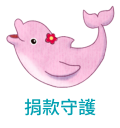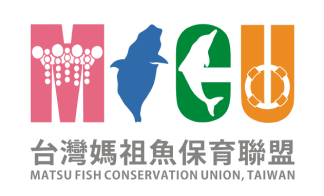2014 台灣白海豚工作坊 05/02新聞稿(中英)文版
2014-05-02
與漁共生,漁豚共榮
推動環境友善漁法,尋求台灣白海豚與漁民共享永續漁業資源之道
新聞稿
2014年5月2日
為拯救極度瀕危的台灣白海豚(印太洋駝海豚),國際學者於台北的研討會結論中指出:推動對台灣白海豚友善的漁法,不僅可以永續台灣漁業資源,同時也為台灣白海豚保留一線生機,達到「與漁共生,漁豚共榮」的終極目標。
從 2007 年開始,由國際學者組成的「東台灣海峽白海豚技術顧問團 ( Eastern Taiwan Strait Sousa Technical Advisory Working Group, 以下簡稱顧問團)」,針對台灣白海豚的保育計畫,研討科學資料及提出實質建議。在中央研究院生物多樣性研究中心、成功大學海洋生物鯨豚研究中心、台灣蠻野心足生態協會與台灣媽祖魚保育聯盟的共同邀請之下,多位顧問團成員與來自巴西、加拿大、墨西哥、紐西蘭、菲律賓、香港、台灣,英國及美國等地小型鯨豚研究的專家學者,齊聚台北與台南,密集討論各項關於台灣白海豚保育的議題,同時檢視過去十年的成果與未來必須積極推動的方向。
台灣白海豚族群棲息在台灣西岸淺海,數量大約僅餘 74 隻。牠們面臨多重生存威脅,包括漁網勒纏(特別是刺網)。海豚若無法掙脫漁網,可能會因此溺斃;即使能夠逃脫,也可能受漁網勒纏造成的割傷所苦,慢慢折磨而死。
根據與會國際專家發表的研究資料顯示,台灣白海豚的族群,有百分之三十以上的個體都帶著漁網勒纏的傷口;有些海豚甚至無法擺脫纏在身上的漁網。被漁網勒纏的海豚,除了肉身與骨骼的痛苦,還可能因此降低覓食和繁殖的能力。
如何恢復台灣白海豚的數量,與會的學者建議可將台灣白海豚的保育目標設定為:在 2030 年以前,將族群數量提升到 100 隻。達到這個目標,即可幫助台灣白海豚,在國際自然資源保育聯盟 (IUCN, International Union for the Conservation of Nature Resources) 的「紅色名錄」(即物種的絕種風險)上,從目前的「極危」狀態,降低成「瀕危」。
身兼顧問團主席、加拿大溫哥華水族館及本次研討會總召的Peter Ross博士指出:「台灣白海豚由於漁網直接或間接的傷害,受盡折磨。」要減輕這樣的生存威脅,並保育這個極度瀕危的物種,必須積極努力在牠們的棲地範圍內,禁用刺網[包括單(多)層流刺、底刺網],並鼓勵漁民改用對環境較友善、更具選擇性的漁法。」
改用較具選擇性的漁法,對漁民也有許多重要的好處,因為漁業資源有機會重生,不僅漁獲因此增加,同時漁獲單價也因為賣相改善而提高,多重增加漁民的收入。
顧問團對林務局近日公告的「白海豚野生動物重要棲息環境」給予正面的鼓勵。
顧問團也進一步建議林務局,應將野生動物重要棲息環境的範圍,修訂為北自苗栗龍鳳港延伸至台南的將軍港,並將西界修訂為距海岸線三海浬。
「野生動物重要棲息環境」的劃設是邁向台灣海豚重要的ㄧ步,但是若要落實保護和恢復台灣白海豚的族群,達到「與漁共生,漁豚共榮」的終極目標,我們必須針對台灣白海豚面臨的生存威脅,包括:汙染、河口淡水注入減少、水下噪音、棲地破壞及魚類資源缺乏等問題,採取更積極、實際的作為。
新聞聯絡人:
中文:
中央研究院生物多樣性研究中心 陳昭倫 0930-073637, [email protected]
成功大學海洋生物暨鯨豚研究中心 王建平 0933-339406
台灣媽祖魚保育聯盟 甘小姐 0928-926180
英文:
Dr. Peter Ross(羅筆德博士)
Program Director, Vancouver Aquarium
tel +1.604.659.3563
e-mail: [email protected]
Taiwanese White Dolphins and fisheries can benefit from dolphin-friendly fishing
International expert group proposes target of 100 dolphins by 2030
2 May 2014
2 May 2014, Taipei: Taiwan’s critically endangered and biologically distinct White Dolphins (Sousa chinensis) and its fishers could both benefit from a switch to dolphin-friendly fishing gear, concluded scientists at an international workshop today in Taipei.
Workshop participants from Brazil, Canada, Hong Kong, Mexico, New Zealand, the Philippines, Taiwan, the United Kingdom and the United States met under the auspices of the Eastern Taiwan Strait Sousa Technical Advisory Working Group, an international group of scientists established in 2007 to provide conservation-based scientific advice to recover the Taiwanese white dolphins.
The Taiwanese white dolphins, which inhabit the nearshore waters of Taiwan’s west coast, number approximately 74 individuals. They face numerous threats, including entanglement in fishing nets, particularly gillnets. Dolphins can drown if they are unable to break free from a net, and such an impact may jeopardize the survival or recovery of the population.
More than 30% of the dolphins bear the scars of previous entanglements, and some dolphins still have nets wrapped around their bodies. This causes terrible suffering and impairs their ability to feed and reproduce.
Workshop participants suggested that Taiwan could set a target to increase the number of dolphins to 100 individuals by 2030. This would improve the population from the IUCN ‘Critically Endangered’ listing to the ‘Endangered’ listing.
Dr. Peter Ross, Chair of the Eastern Taiwan Strait Sousa Technical Advisory Working Group and Program Director at the Vancouver Aquarium in Canada, said: “The Taiwanese white dolphins are suffering from terrible injuries associated with fishing nets. The best hope to reduce this threat, and recover this critically endangered population, would come from banning gill nets in their habitat, and encouraging fishers to switch to more selective fishing gear.”
Switching to alternative, more selective fishing methods can also bring significant benefits to fishers, with recovering fish stocks leading to increased income for fishers.
The international expert group welcomed the recent announcement by the Forestry Bureau that it will soon designate Major Wildlife Habitat for the dolphins.
The expert group encouraged the Forestry Bureau to consider increasing the Major Wildlife Habitat area from Longfeng Harbour (Miaoli County) in the north to Jiangiyun Harbour (Tainan City) in the south, and increasing the offshore boundary to 3 nautical miles from the shore.
The designation of Major Wildlife Habitat represents a management tool, but it will only be meaningful if accompanied by actions to reduce the threat from pollution, freshwater diversions, noise, habitat destruction and fisheries impacts.
ENDS
For further information or to arrange an interview, please contact:
Mandarin Chinese: Dr. Allen Chen, Academia Sinica, +886-930-073637, email:[email protected]
English: Dr. Peter Ross, Program Director, Vancouver Aquarium, tel ++1.604.659.3563, email[email protected]
相關文章
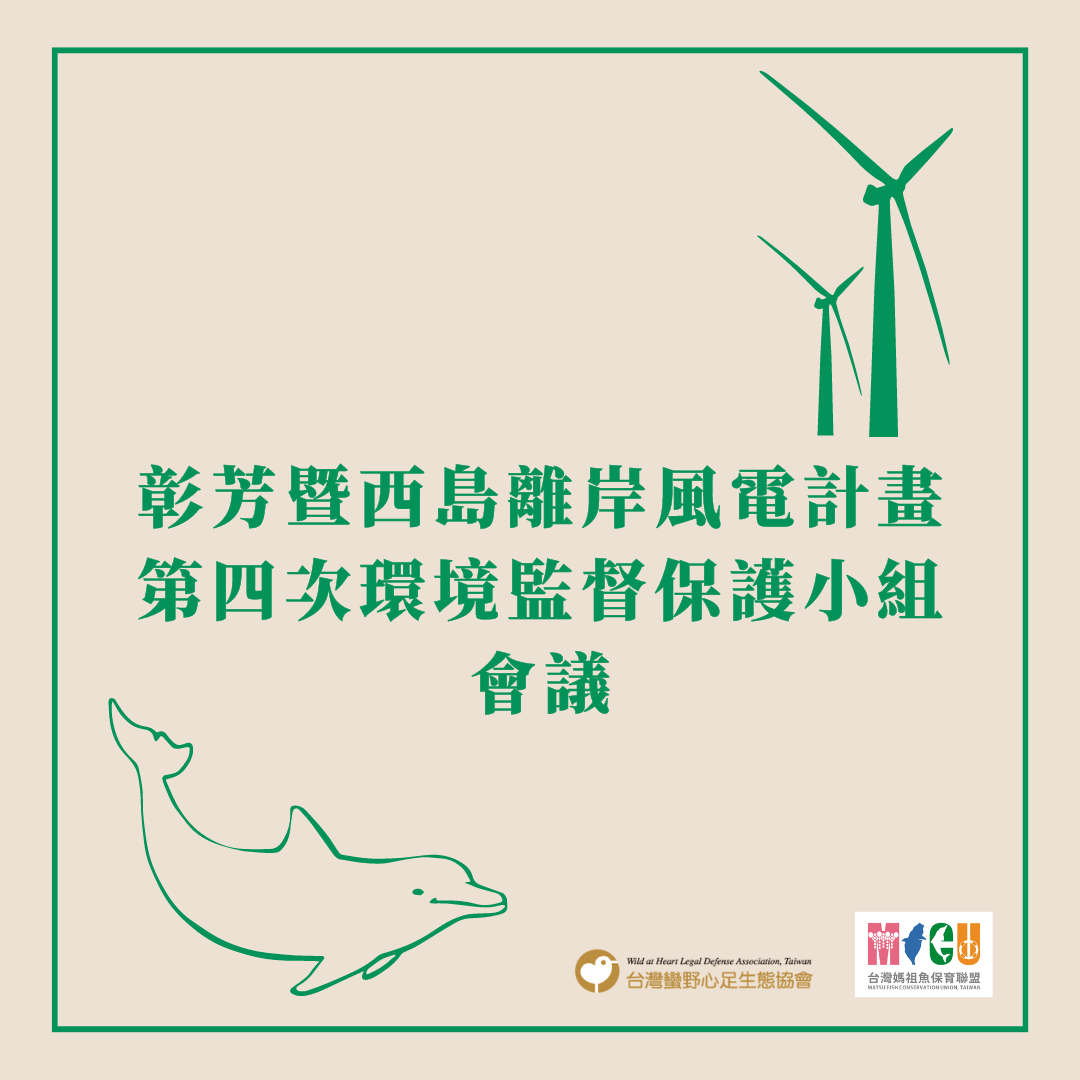
彰芳暨西島離岸風電計畫第四次環境監督保護小組會議
發言單 111.06.20 台灣蠻野心足生態協會 施仲平 研究專員 首先感謝CIP願意讓非委員的團體(民眾)參加環境監督保護小組會議,落實資訊公開及全民把關的理念,以下針對過去一年的風場環境監測報告(主要為鯨豚有關的部分)提供幾點建言: 1.盼能增加環境監督保護小組會議頻率 我國許多風場召開此類會議的頻率都高於一年一次,不少委員也都提到其職責為審查每一季的環境監測報告,如此低頻度的開會實在很難做到即時的反應問題、在第一時間內控制不良影響,如同我們發現貴單位方才的報告有許多可以改善的點,但卻在今年度所有海域施工都已結束才召開這個會議讓我們反映,實為可惜,且討論的東西要相隔一年再接續也不切實際,建議開發單位可以參考其他風場把會議頻度提高到半年一次甚至一季一次。 2.圖表名稱錯誤 簡報第43頁左邊的兩張圖,圖表內容明顯不同,但圖表名稱卻都相同,雖比照下一頁簡報可以得出正確名稱,但以一個準備一年報告的簡報實再不合格,希望下次能多留心。 3.民國109年監測資料遺失 簡報第43頁及44頁的圖表中,完全沒有109年的資料,想詢問開發單位是座標誤植?還是該年度資料遺失?抑或是未進行監測?請詳加說明。 4.資料結果解釋避重就輕 由簡報第43頁及44頁的圖表可得出最直觀的結果應該是施工期間鯨豚活動(偵測到叫聲)「顯著」降低,尤其如海保署長官所說──圖表縱軸是等比而非等差,此差異再明顯不過,而分析完的文字說明竟然只得出鯨豚活動熱點並無顯著區域性差異此議結論,相信任何一位學過統計的人判讀這幾張圖表得出的資訊絕對和簡報的重點不同,除非開發單位有特定意圖,否則以後請完整呈現監測數據所反映的資訊。 5.白海豚重要棲地的水下噪音測站位置設計不佳 我們都知道噪音的音量會隨著傳遞距離遞減,因此若我們要了解風場工程噪音傳到台灣白海豚重要棲息環境的邊界分貝有多大,理論上應是設在離打樁點距離最短的位置,然而我們看到簡報第46頁,重棲邊界測站到最近風機的距離竟是上述最短距離的3倍以上,測得的數值實在無太大意義,建議開發單位提供海域工程噪音傳到重棲邊界的「最大音量」資料。 6.圖表標示不清、圖例闕漏 簡報第28、45、46出現圖例缺漏(或錯誤)造成閱讀者無法正確接收資訊,且多張圖片都是直接使用英文而未附註中文,加上前述圖表名稱錯誤,會讓人感覺多少有點放圖了事的感覺在,好像不是很用心準備這場一年一度的監督小組會議,請開發單位下次能及早並嚴謹準備會議資料。 7.施工噪音超標 簡報第47頁有看到許多打樁噪音監測值超過160dB而違反環評承諾,我們首先要肯定CIP的坦蕩與誠實,不像我們私下了解的某些開發單位會對超標數據動手腳而不如實稟報;然而下一步我們想知道的是貴公司是否有去釐清噪音超標的原因?以及未來將如何預防?至少現在的雙層氣泡幕及超過155dB的應變措施顯然無法有效排除噪音超標的現象。 8.觀測到瓶鼻海豚的因應對策? 簡報第48頁提到在風場範圍內有多次觀測到瓶鼻海豚的紀錄,可見該海域乃瓶鼻海豚的棲地,又瓶鼻海豚與白海豚同為我國海洋一級保育類動物,請現有針對瓶鼻海豚的研究已知音量大於137dB即會對其產生負面影響,換句話說現有的噪音防制措施並不足夠,請問貴公司對此有什麼進一步策略? 9.船速限制不足 本案雖是第二階段(潛力場址)的風場,然而近期三階風場的環評資料已有新的科學研究顯示本案所採的「白海豚重棲海域船速控制不超過6節」實際無法保障到白海豚,請問貴公司是否能就最新研究承諾船速限制比較他案風場下修至3(有的甚至承諾2)節?2022-10-22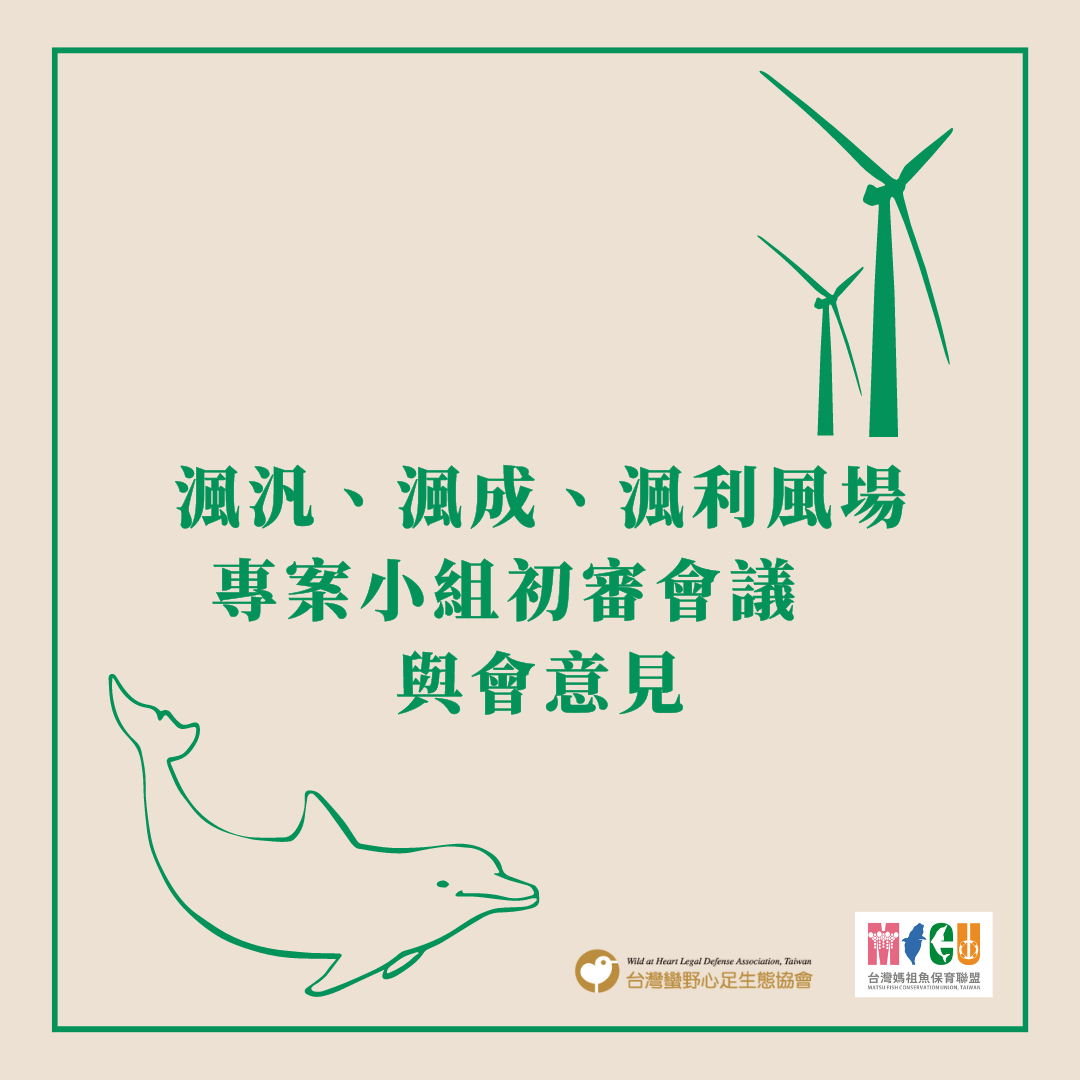
渢汎、渢成、渢利風場專案小組初審會議 與會意見
111.10.05 台灣蠻野心足生態協會 研究專員 施仲平 程序問題 充分的事前準備才能讓一場會議發揮最大效益。環評施行細則明訂「環說書初稿及開會資訊需於會議前七日公告」,目的即是讓各方參與者在會前能有充分的時間做準備;惟目前會議所討論的標的都已演變為使用「由環說書整理後的簡報」,且常見環評委員要求開發單位「將簡報內容確實納入環說書中」,可見光靠環說書初稿是無法充分準備會議將討論到的所有範疇,因此,我方認為環保署要求開發單位在會前繳交的會議資料亦屬環評施行細則規定開會資訊之一,需在七日前提供;然而近幾次環評會議,開發單位都未能在法規期限內公告會議資料,我們主張會議有嚴重程序瑕疵,應屬無效。 遺憾的是,環保署卻在會議上主張,官網所公告的會議資料並不屬於開會資訊範疇,該署發函給開發單位的公文僅要求會議前一日中午十二點前提供即可;然而,就算簡報依照環保署的說法不用七日前公開,其函文要求會前一日提供的期限,開發單位也未遵守;無論用七日還是前一日中午來算,開發單位逾期未提供會議資料是不爭的事實,環保署實在不應再以「逾期未達違法」的說詞來替開發單位辯解,強行召開有程序瑕疵的審查會議。 環說書內容問題 同時間打樁協調機制 打樁噪音對海洋生物的危害眾所皆知,本次審查三案雖承諾連審風場同意時間僅會有1支基樁進行施作,然鄰近海域未來仍可能有他案風場陸續通過,建議開發單位比照其他風場承諾建立施工協調機制,和鄰近海域未來將同時施工的風場協調輪流打樁。請承諾用最佳噪音防制工法 目前開發單位環說書文字為「全程採用雙層氣泡幕或減噪阻尼樁錘或導架內建局部氣泡幕或其他已商業化之最佳噪音防制工法」,然而依現行文字將造成未來若有更佳的已商業化噪音防制工法,開發單位仍得選用雙層氣泡幕或減噪阻尼樁錘或導架內建局部氣泡幕等屆時非最優的工法施作,顧建議直接承諾「全程採用已商業化之最佳噪音防制工法」即可。船速仍然過快 本三案計畫承諾「施工作業之船隻,行經中華白海豚野生動物重要棲息環境及邊界以外 1,500 公尺範圍時,船隻速度應控制在 6 節以下。另行經其他海域範圍,倘發現鯨豚時,施工船隻行駛速度亦將調整至 6 節以下。」,然而其他風場乃承諾降至3節,若本案其他條件無相異之處,理應比照辦理,方能達到對鯨豚保護之效果。打樁噪音閾值仍過高 本三案所承諾的海域施工噪音累積量百分之五不得超過SEL05160分貝(dB re.1μPa2 s)、單次不得超過SPLpeak190 分貝(dB re.1μPa)以及打樁750m處測量噪音達SEL30s158分貝(dB re.1μPa2 s)十,將採取應變措施等噪音防制承諾,仍然不足!且已違反區塊開發政策環評所要求管制閾值須參國內外最新學術研究近型滾動式修正。建議參考台大楊瑋誠教授研究結論,將海域噪音管制閾值至少下修至137分貝。打樁之鯨豚保護措施顯有漏洞 環說書中將打樁半徑750公尺至1,500公尺劃設為預警區,並承諾發現鯨豚進入預警區,則觀察記錄其目擊資料與移動方向,確認鯨豚沒有往警戒區移動跡象,基樁至750公尺處則是警戒區,確認警戒區連續30分鐘無鯨豚進入方可打樁,然而人員目視監看容易受海況影響能見距離,聲音監測法目前也無法精確判定距離,試問開發單位如何確保此套保護措施在海況或能見度不佳的情況下正常運作?如何確保鯨豚能有效被保護?補救措施毫無功能 水下聲學在施工前、海域施工期及營運期的監測計畫,備註都出現若水下聲學儀器、數據回收遺失之海象條件不佳,如無法補測測滿14天,將待量測時間滿 24 小時,即回收各點位儀器;然而此補救措施根本達不到監測目的第一點「建立開發各階段之環境品質資料,掌握長期環境品質改變趨勢。」的功能,海保署的建議甚至是每季至少監測20天,而上開補救措施竟妄想以一日之資料建構一季之海況資料庫,這種為補做而補做的應付行為,若達不到監測目的根本毫無意義,完全是為了交差而已!請環保署否決本案並要求提出其他實質有效的補測方案。2022-10-08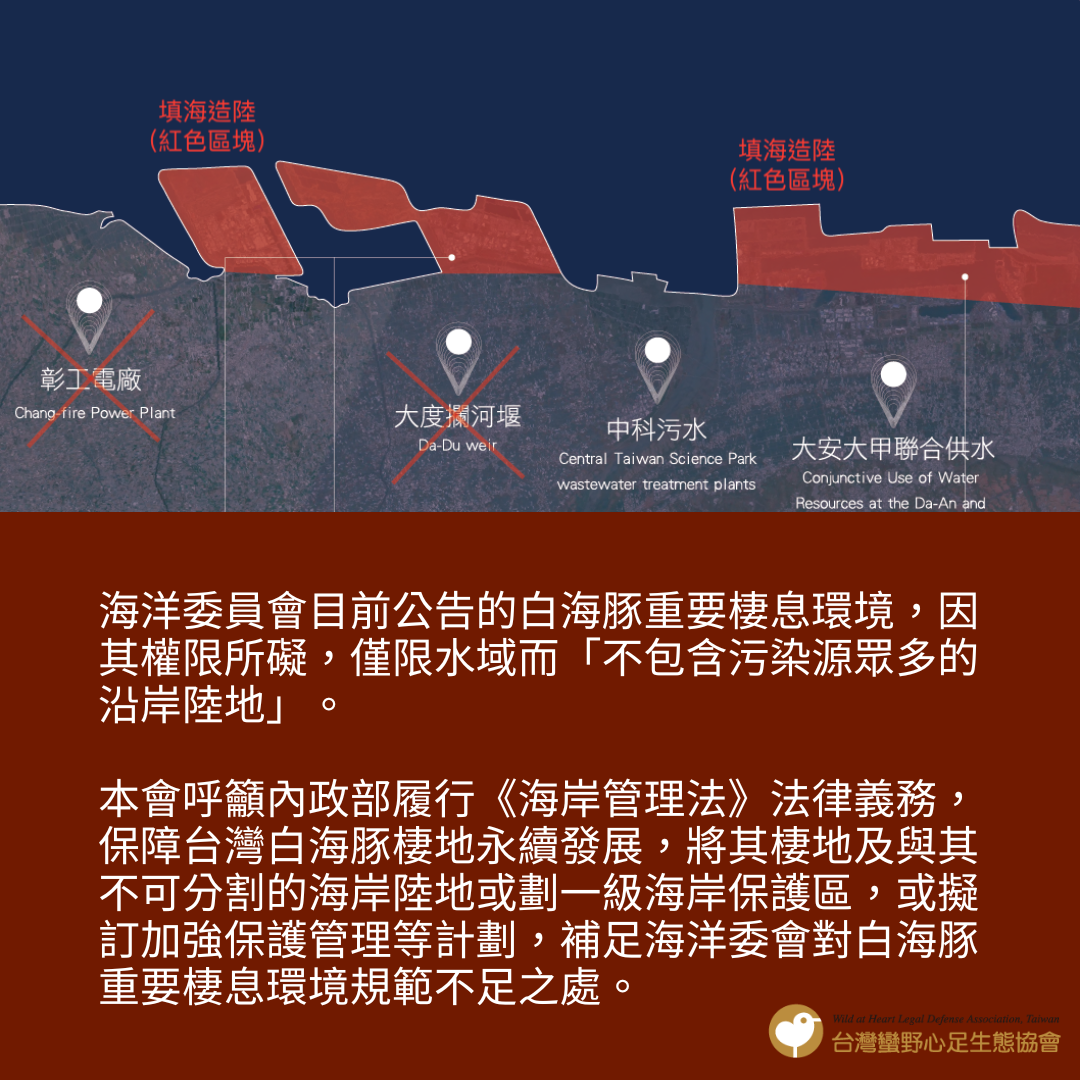
海岸管理鑑往知來制度策進座談會(與會意見)
台灣媽祖魚保育聯盟 秘書 施仲平 (111.09.20) 就議題一討論重點三實務面臨問題提請討論(簡報第14頁) 所涉法條 海岸保護區之原則 《海岸管理法第2條1項1至3款》 本法用詞,定義如下: 一、海岸地區:指中央主管機關依環境特性、生態完整性及管理需要,依下列原則,劃定公告之陸地、水體、海床及底土;必要時,得以坐標點連接劃設直線之海域界線。 (一)濱海陸地:以平均高潮線至第一條省道、濱海道路或山脊線之陸域為界。 (二)近岸海域:以平均高潮線往海洋延伸至三十公尺等深線,或平均高潮線向海三浬涵蓋之海域,取其距離較長者為界,並不超過領海範圍之海域與其海床及底土。 (三)離島濱海陸地及近岸海域:於不超過領海範圍內,得視其環境特性及實際管理需要劃定。 《海岸管理法第8條1項7款》 為保護、防護、利用及管理海岸地區土地,中央主管機關應擬訂整體海岸管理計畫;其計畫內容應包括下列事項: 七、保護區、防護區之區位及其計畫擬訂機關、期限之指定。 《海岸管理法第10條1項1款》 一級海岸保護計畫:由中央目的事業主管機關擬訂,涉及二以上目的事業者,由主要業務之中央目的事業主管機關會商有關機關擬訂。 《海岸管理法第12條1項2款》 海岸地區具有下列情形之一者,應劃設為一級海岸保護區,其餘有保護必要之地區,得劃設為二級海岸保護區,並應依整體海岸管理計畫分別訂定海岸保護計畫加以保護管理: 二、珍貴稀有動植物重要棲地及生態廊道。 《海岸管理法第12條2項》 一級海岸保護區應禁止改變其資源條件之使用。但有下列情況之一者,不在此限: 一、依海岸保護計畫為相容、維護、管理及學術研究之使用。 二、為國家安全、公共安全需要,經中央主管機關許可。 《海岸管理法第12條3項》 一級海岸保護區內原合法使用不合海岸保護計畫者,直轄市、縣(市)主管機關得限期令其變更使用或遷移,其所受之損失,應予適當之補償。在直轄市、縣(市)主管機關令其變更使用、遷移前,得為原來之合法使用或改為妨礙目的較輕之使用。 《海岸管理法第13條1項1至3款》 海岸保護計畫應載明下列事項: 一、保護標的及目的。 二、海岸保護區之範圍。 三、禁止及相容之使用。 海岸保護區之例外 《海岸管理法第13條2項》 依其他法律規定納入保護之地區,符合整體海岸管理計畫基本管理原則者,其保護之地區名稱、內容、劃設程序、辦理機關及管理事項從其規定,免依第十條及第十二條規定辦理。 《海岸管理法第13條3項》 前項依其他法律規定納入保護之地區,為加強保護管理,必要時主管機關得依第一項第三款規定,擬訂禁止及相容使用事項之保護計畫。 白海豚重要棲息環境之情況 臺灣白海豚生活之海域為臺灣西海岸由桃園至台南30米深以內水域及各大河口,且該水域高度受到沿岸之陸域人為活動影響,屬於《海岸管理法》第2條所規範之海岸地區。 臺灣白海豚屬我國海洋一級保育類動物,其棲地範圍(含濱海陸地足影響海域之部)乃《海岸管理法》第12條1項所明定應劃為一級海岸保護區之海岸地區。海洋委員會海洋保育署依《野生動物保育法》劃設了臺灣白海豚重要棲息環境,看起來似乎符合《海岸管理法》第13條2項免依同法第10條及第12條辦理之情形。然而,《海岸管理法》第13條2項此一但書之前提乃「符合整體海岸管理計畫基本管理原則」始得適用,那究竟海委會依野保法所劃設的臺灣白海豚重要棲息環境是否符合上開前提呢?讓我們來看看「整體海岸管理計畫基本管理原則」是怎麼規定的──中華民國106年2月由內政部公告的「整體海岸管理計畫」第4-21頁4.1.3保護計畫擬定機關期限之指定此一章節,即闡明有關「符合整體海岸管理計畫基本管理原則」,係指相關目的事業主管法令或其授權訂定之相關計畫及書件等,得確保各該海岸保護區之『保護標的』不致遭受破壞。回頭檢視海委會公告的白海豚重要棲息環境,其範圍僅由海上劃至平均高潮線,也就是說完全不包含《海岸管理法》第2條所定義的濱海陸地、離島濱海陸地及近岸海域型海岸,然而我們知道臺灣西海岸遍布大大小小的工業區,其中不乏濱海型及離島型,而這些大規模的污染源正是官方報告的臺灣白海豚六大威脅之一──水、空污染,甚至70%以上的臺灣白海豚皆因此患有皮膚病,也就是說海委會依法劃設的保護區範圍(及措施),未能及於海岸污染源,而其本身也承認這些污染源是該保護區保護標的的重大威脅,也就是說,在各個案例裡面,目的事業主管機關所訂定的法規、措施或計畫,無法確保「保護標的不致遭受破壞」,並不符合《海岸管理法》第13條2項免依第10條及第12條辦理的條件。 13條2項免依第10條及第12條辦理的條件 《海岸管理法第13條2項》 依其他法律規定納入保護之地區,符合整體海岸管理計畫基本管理原則者,其保護之地區名稱、內容、劃設程序、辦理機關及管理事項從其規定,免依第十條及第十二條規定辦理。 第十條及第十二條規定辦理。 緣此,內政部必須回歸原則性的操作,依同法第10條及第12條劃設有效的一級海岸保護區,不要忘記是「應」劃設(羈束處分),且第12條2項例外可使用的「依海岸保護計畫為相容、維護、管理及學術研究之使用。」、「為國家安全、公共安全需要,經中央主管機關許可。」,我相信彰濱工業區、麥寮工業區等應非屬上開兩種但書範圍,才不會導致我們在海裡保護白海豚忙得焦頭爛額,隔個一排消波塊的工廠在海堤的另一端大肆排放污水及廢棄,這種保育邏輯傳出去必定貽笑大方。 所以,我今天要凸顯的問題是:假如其他部會依法採取某些保護措施,而該措施明顯無法達到保護效果、無法符合整體海岸管理計畫基本管理原則,而內政部卻以尊重其他部會一句話就帶過,無疑是實質架空海岸管理法的條文、怠於執行法律課予貴部的義務;若不論什麼情況下都無法實際進行《海岸管理法》第13條2項「有無符合整體海岸管理計畫基本管理原則」的審查,或執行同條3項的「為加強保護管理,必要時主管機關得依第一項第三款規定,擬訂禁止及相容使用事項之保護計畫。」,則此二條法條豈非形同具文?請貴部釋明在何種時機下將會履行法律義務,做一個確實依法行政的機關。2022-09-23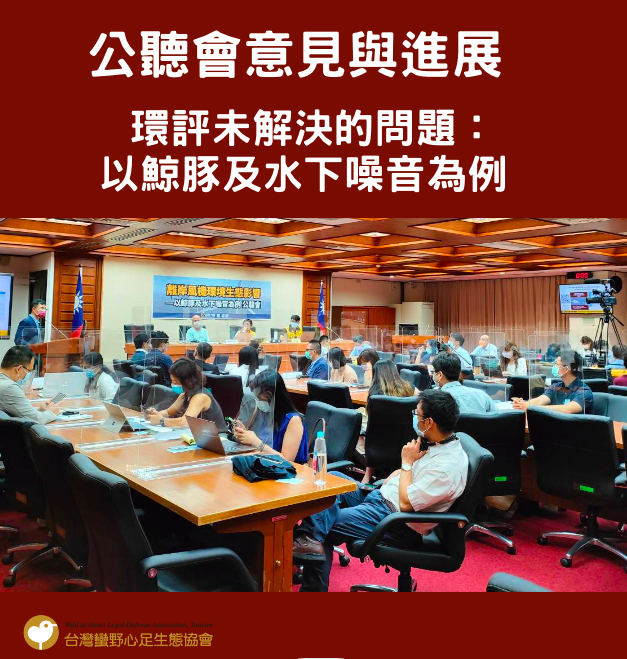
【守護鯨豚、釐清離岸風機生態影響】 公聽會結論
1. 根據本次專家學者公聽會,以台灣西部海域與白海豚同為保育等級 I 的露脊鼠海豚來說,其棲地位於近岸風場內,需要即刻注意,且由於露脊鼠海豚較白海豚敏感,造成其聽力損傷的聲曝值須採取較750m 160 dB SEL 更嚴格的標準。 2. 對於台灣極度瀕危物種台灣白海豚保育而言,160 dB SEL僅是無聽覺暫時受損的標準,並不足以保護瀕危物種免於行為與生理負面影響,建請盡速增訂工程噪音擴散至白海豚棲地內之標準。 3. 根據本次公聽會專家建議,160分貝之規範並未考量離岸風機大規模開發之累積效應,長期下來可能造成鯨豚聽力損傷與生理行為影響,加上百分之五的超標容許值,對於極度瀕危物種而言,會有重大影響。離岸風機同時且長期施工時的累積效應,建議盡速提出過往監測分析報告,做為立刻改善的依據。請環保署積極監督。 4. 應該制定嚴謹且有強制力的離岸風力發電生態調查方法,並明確要求離岸風機環評需遵守該生態指引,建請環保署將指引納入環評的條件,建請能源局納入評選的條件。 5.請國科會積極協助,我國離岸風電開發所需之基礎科學研調計畫,就海洋野生動物而言,重要的科學資訊至少包括:長期工程噪音造成鯨豚生理行為影響以及其適應和恢復的時間、風場物種多樣性和關鍵物種的數量與分佈,並應該要持續掌握數量與分佈的動態變化。環評過程中,開發單位各項監測資訊應公開或共享,政府單位應對各項調查資料加以整合,不僅有助於完備台灣海域基礎調查,更是海洋保育的第一步。 6. 請漁業署積極與開發商協力,整合各項回饋金計畫,積極推動海洋生態資源保育工作,促進漁業永續發展。 7. 台灣長期以來忽略水下噪音所造成的環境影響,根據海洋汙染防治法所定義之污染行為係指直接或間接將物質或能量引入海洋環境,致造成或可能造成人體、財產、天然資源或自然生態損害之行為;建請環保署應積極建立嚴謹的水下噪音評估規範。 8. 現今已開發或施工中之離岸風場已造成苗栗、彰化、雲林海域鯨豚擱淺數量異常增加,海中的保育類鯨豚行為已明顯受到離岸風電施工的影響並失去生命,漁民因漁業權損失而有補償金的機制但保育類動物的鯨豚卻什麼都沒有,離岸風場開發商應付起相關的企業與環境責任提出鯨豚擱淺救援協助機制並投入相關資源支持海保署進行我國海洋環境之保護行動。 9. 為保護保育類露脊鼠海豚與瀕臨滅絕的台灣白海豚,建請海保署、環保署及能源局研議,離岸風機獲得施工許可之後,在正式施工階段之前,建立海事許可制度,開發單位應提出實際之打樁減輕及減噪計畫,公開水下噪音監測資訊。 10. 為兼顧再生能源與生態保育,本辦公室原則上每月邀請各單位,分別就各項改善措施進行討論、追蹤進度。 緣起:離岸風力發電是台灣政府發展再生能源的主力之一,然而過去因缺乏充足的海洋環境生態基礎資料,#開發的速度大於環境影響減緩對策推動的速度。因此此次公聽會以 #鯨豚生態影響 及 #水下噪音 問題為主題,請經濟部、環保署、海委會等機關列席說明。並邀請專家學者,就生態影響問題及對策進行討論,加速制定相關規範以及具體措施。 #立委承諾制訂離岸風機相關生態保護標準 目前已經有多個風場陸續完工,但應該是最基本的「 #離岸風場生態調查指引 」至今還沒有公告,不具任何強制力。隨著更多風場的施工,恐怕對 #海洋生態 ,特別是 #仰賴聲納系統的鯨豚 造成嚴重的影響。公聽會中,陳椒華委員承諾每月將邀請專家學者與公部門,針對如何制定符合我國保育需求的 #水下噪音標準 、 #施工規範 、 #生態監測 、 #資訊公開 與 #回饋金如何有效促進永續漁業 等問題進行研商。 #台灣白海豚、江豚屬於極危,噪音預防標準應更加嚴謹 本會理事長文魯彬呼籲:目前160dB SEL的水下噪音標準,是參考國外港灣鼠海豚所制定,然而港灣鼠海豚族群數量有30萬隻,跟台灣瀕臨滅絕的白海豚處境完全不同,應該檢討目前水下噪音標準。而且目前的環評只評估個別的開發案,現況是 #同時有許多風場在施工, #累計的影響會更大。台大獸醫系教授楊瑋誠說,以在台灣白海豚及江豚的案例,目前研究大概140dB就足以造成其生理緊迫。 台大楊瑋誠教授認為:#根據研究長時間暴露在SEL 140dB 噪音下,就會對鼠海豚造成生理上的影響。 知洋科技湛翔智博士也舉國際上的案例,噪音對鯨豚的影響評估其實是建立在噪音音量的模擬及鯨豚出現的機率,若未建立穩定族群監測數據,則所謂做的影響評估其實是「零」, 建議我國離岸風機施工時,應參考先進國家,在環境的監測與減緩工作,必須訂定詳細的指引。 #噪音已造成西海岸鯨豚擱淺數量上升 中華鯨豚協會秘書長曾鉦琮示警,近年來離岸風電的施工,可能是造成比白海豚更容易受到水下噪音影響的鼠海豚擱淺數量急遽上升的主因。台大楊瑋誠教授認為:#根據研究長時間暴露在SEL 140dB 噪音下,就會對鼠海豚造成生理上的影響。 主辦單位: #陳椒華立委辦公室、#台灣蠻野心足生態協會、#台灣媽祖魚保育聯盟 會議資料:https://shorturl.at/lnv392022-09-01
